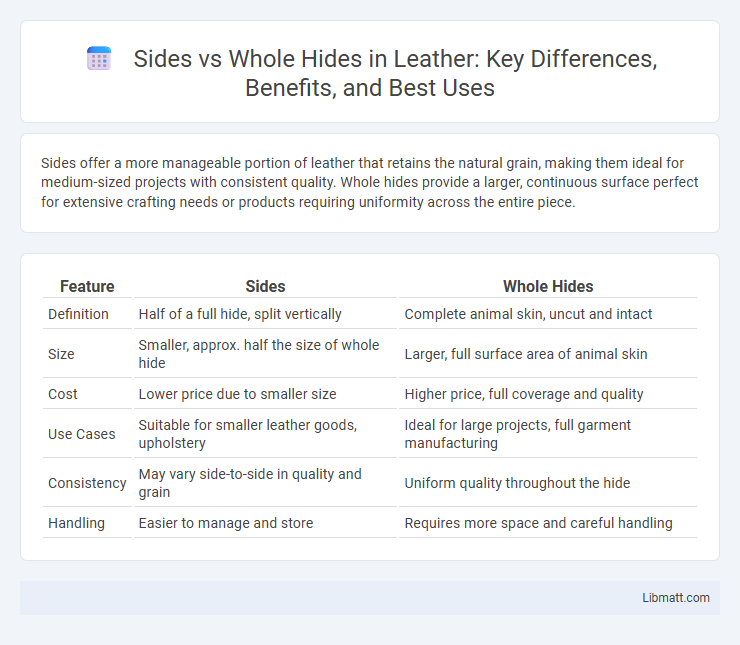Sides offer a more manageable portion of leather that retains the natural grain, making them ideal for medium-sized projects with consistent quality. Whole hides provide a larger, continuous surface perfect for extensive crafting needs or products requiring uniformity across the entire piece.
Table of Comparison
| Feature | Sides | Whole Hides |
|---|---|---|
| Definition | Half of a full hide, split vertically | Complete animal skin, uncut and intact |
| Size | Smaller, approx. half the size of whole hide | Larger, full surface area of animal skin |
| Cost | Lower price due to smaller size | Higher price, full coverage and quality |
| Use Cases | Suitable for smaller leather goods, upholstery | Ideal for large projects, full garment manufacturing |
| Consistency | May vary side-to-side in quality and grain | Uniform quality throughout the hide |
| Handling | Easier to manage and store | Requires more space and careful handling |
Introduction: Understanding Sides vs Whole Hides
Sides refer to leather obtained by splitting a whole hide vertically into two halves, typically halving the total surface area, which impacts the leather's durability and application. Whole hides offer the complete, uncut animal skin, preserving its natural grain and strength, preferred in high-quality leather products requiring uniformity and resilience. Choosing between sides and whole hides depends on specific manufacturing needs, with sides suitable for smaller goods and whole hides ideal for larger, premium leather goods.
Definition: What are Sides and Whole Hides?
Sides are leather pieces made by splitting a whole hide into two halves, typically resulting in a left and right side, each used for different leather products. Whole hides refer to the entire animal skin, preserved and processed without splitting, offering more surface area and uniformity for larger applications. The choice between sides and whole hides depends on the specific leather requirements, with whole hides preferred for larger items and sides suited for smaller goods or components.
Processing Differences: Sides vs Whole Hides
Processing differences between sides and whole hides primarily involve handling and preparation complexities; sides are halved hides that require separate splitting and trimming, making the workflow faster but possibly less uniform. Whole hides maintain the entire animal's skin, offering a continuous grain and consistent thickness, but demand more extensive dehairing, fleshing, and drying processes. Your choice impacts tanning methods, with sides allowing easier inspections and treatments, while whole hides require advanced equipment to manage their larger size.
Material Quality and Consistency
Whole hides offer superior material quality and consistency compared to sides due to their intact grain structure and uniform thickness throughout the entire skin. Sides, being split sections of the hide, often show variations in texture and potential imperfections caused by stretching or cutting, which can affect the overall durability and finish. Choosing whole hides ensures a more reliable and premium leather source for high-end products requiring consistent performance and appearance.
Size and Yield: Which Offers More Usable Leather?
Whole hides provide a larger and more continuous surface area, resulting in higher yield and fewer irregularities compared to sides, which are halves of a hide. Sides typically offer less usable leather due to their reduced size and the increased likelihood of defects or cuts along the edges. For industries requiring maximum material efficiency and minimal waste, whole hides are generally preferred for producing larger leather goods.
Cost Comparison: Sides vs Whole Hides
Sides generally cost less than whole hides due to their smaller size and reduced processing requirements, making them a budget-friendly option for leather crafters. Whole hides, while more expensive, offer greater material continuity and versatility, which can lead to lower waste and better value in large projects. Cost differences vary depending on hide quality, tanning method, and supplier, but sides typically represent a 30-50% savings compared to whole hides.
Applications: Best Uses for Sides
Sides are ideal for applications requiring larger, more flexible leather pieces, such as upholstery, saddlery, and larger garment panels. They provide greater uniformity and fewer seams compared to smaller cuts, making them perfect for crafting durable, high-quality products like jackets, bags, and furniture coverings. Your projects benefit from sides when consistent grain and strength across broad surfaces are essential.
Applications: Best Uses for Whole Hides
Whole hides are ideal for applications requiring large, uncut leather surfaces such as upholstery, large bags, and custom furniture projects, ensuring durability and consistency across the material. Their seamless nature provides superior strength and aesthetic appeal, making them preferred for high-end leather goods like saddles and jackets. Choosing whole hides ensures Your project benefits from uniform texture and fewer imperfections compared to sides.
Storage and Handling Considerations
Sides require less storage space than whole hides due to their reduced size and ease of stacking, making them ideal for smaller workshops or limited storage facilities. Handling sides is generally more manageable, reducing the risk of damage during transportation and processing compared to bulkier whole hides. However, whole hides offer uniformity and fewer seams, which may be preferred for certain manufacturing processes despite the increased storage and handling challenges.
Choosing the Right Option for Your Leather Project
Sides offer uniformity and ease of handling, making them ideal for smaller leathercraft projects like wallets and small accessories. Whole hides provide the advantage of maximum material with natural grain patterns, perfect for large-scale items such as upholstery and saddlery. Assessing the scale and detail of your project ensures selecting sides or whole hides optimizes material usage and quality outcomes.
Sides vs whole hides Infographic

 libmatt.com
libmatt.com